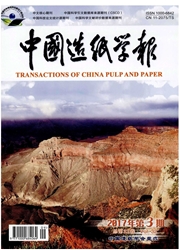

 中文摘要:
中文摘要:
进行木质纤维氨化反应研究,结果显示,氨水用量对氮含量影响最大,其次为反应温度,再次为过氧化氢用量和反应时间,实验条件下麦草木质纤维最佳氨化条件为:时间0.5 h,温度150℃,氨及过氧化氢用量分别为18.36%和33.0%(相对木质纤维绝干质量),其中氨水内13.75%的氮结合到木质纤维的木素分子上。氮化反应过程中,木素结构发生了明显的变化,木素大分子在高温条件和过氧化氢作用下发生了部分降解,木素表面有严重的碎裂化现象,还发生了侧链氧化和芳香环开裂等反应。在1^H-NMR谱图中可清晰看出,在化学位移5.45处有明显的N—H峰,表明有氨基的结合。
 英文摘要:
英文摘要:
Ammoniation of lignocellulose fiber was studied in this paper. It was found that among the factors affecting the nitrogen content in- corporated their importance sequence was the ammonia charge, then the temperature and finally the amount of hydrogen peroxide added and the reaction time. Under experiment conditions, the optimized ammoniation of straw lignocellulose fiber conditions are :0.5h, 150℃;, ammonia charge 18.36% and hydrogen peroxide charge 33.00%. About 13.75% of nitrogen in the ammonia incorporated into the lignin molecule at the optimal ammoniation condition. During ammoniation, molecule structure of lignin underwent drastic changes, the surface of the lignin macmmolecule was smashed extensively. From 1^ H-NMR spectrum it was clearly revealed that there was a shift peak at 5.45 ppm, indicating the nitrogen was incorporated into the lignin macromolecule.
 同期刊论文项目
同期刊论文项目
 同项目期刊论文
同项目期刊论文
 期刊信息
期刊信息
